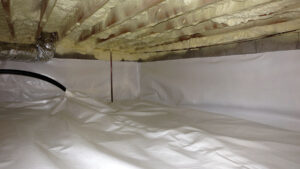 The floors over your crawlspace should not be cold in the winter. I know it’s easy for me to say, but that’s the truth. And, neither should the floors over a basement. If you think about it, there is no difference between a crawlspace and basement, the crawlspace is just shorter. So why is your crawlspace cold? Have you actually looked in your crawlspace and noticed any insulation anywhere?
The floors over your crawlspace should not be cold in the winter. I know it’s easy for me to say, but that’s the truth. And, neither should the floors over a basement. If you think about it, there is no difference between a crawlspace and basement, the crawlspace is just shorter. So why is your crawlspace cold? Have you actually looked in your crawlspace and noticed any insulation anywhere?
In my experience, many times the crawlspace is ignored during construction. Foundation vents are installed to let the moisture out, and insulation is not a consideration.
What blows my mind is when heated air is intentionally blown into the crawlspace in a feeble attempt to warm the floors above. What is actually happening is the heat from the ducts flows right out the foundation vents and dramatically increases the utility bills. This is just insane!
The recipe for having warm floors over a crawlspace is not a huge secret. Install a vapor barrier over the crawlspace floor, block and air seal the foundation vents, and insulate the foundation walls. This will make the crawlspace a conditioned space. Meaning we would like for the crawlspace to be the same temperature as the living space above.
The only thing that would prevent us from bringing a crawlspace into the conditioned space is if the crawlspace gets wet. Crawlspaces can be put into two different categories, wet and dry. If there is standing water, or at different times of the year water flows into the crawlspace, or it is prone to flooding, then the crawlspace would need to be treated differently. It is more difficult and more expensive but we cannot trap water in the crawlspace or we will create many other problems.
The following is the most efficient and cost effective way of treating a crawlspace that does not have excessive water problems. To make the crawlspace a conditioned space there are some basic rules that need to be followed:
• Vapor barrier – Install a vapor barrier over the dirt floor with all of the seams taped and sealed. Seal off the perimeter of the vapor barrier to the foundation wall 12 inches up the wall. This can be done by using furring strips and concrete screws to pinch the vapor barrier to the foundation. Keeping the moisture out of the crawlspace is very important. Most specifications call for a six-millimeter plastic. Most six-millimeter plastic sheeting is made out of recycled materials and will disintegrate in just a few years. Use a vapor barrier that is puncture resistant and engineered for the crawlspace application. The concrete peers also need to be wrapped and sealed to keep moisture from migrating up through the concrete.
• Foundation vents – Seal off the foundation vents with rigid foam board and seal around the perimeter of the board. They will be insulated with spray foam in the next step.
• Insulation – To insulate the foundation walls of the crawlspace, the most effective insulation system is to use two-part spray foam. Either open cell or closed cell will both work just fine. Apply the foam to the rim joist to air seal and insulate, and then down the foundation wall and onto the vapor barrier over the floor.
If you have a wet crawlspace making it a conditioned space is not possible, it will need to be treated much differently:
• Vapor barrier – Install a vapor barrier as previously described.
• Insulation – Instead of applying insulation to the foundation walls, it will need to be installed directly to the bottom of the floor that you walk on. In my opinion, you should apply two-part spray foam directly to the

underside of the sub-floor. Fiberglass batt insulation normally does not work well and will not stand the test of time. It will absorb moisture, gain weight and fall into the crawlspace.
• Ducts – Air seal and insulate all of the supply and return ducts in the crawlspace. This is time consuming and costly, but necessary.
• Plumbing – Insulate the water and drain lines to prevent freezing in the winter because the air temperature in the crawlspace will be colder once the floor and the ducts are insulated.
If you do not have any heating ducts in the crawlspace, then it would be best to apply the insulation to the bottom of the floor since there would not be anything to heat the crawlspace and keep the floors warm.







